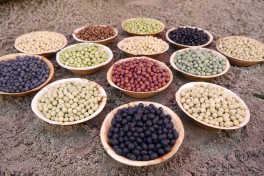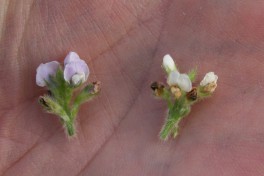Edamame-Soya Varieties
Big and delicious is what they should be!
Each soya bean can be harvested and eaten as a green pod. However, enjoyment only comes from eating the edamame soya varieties traditionally cultivated specifically for this purpose. Edamame soya beans therefore form a very special group of soya bean varieties with a range of tastes, colors and cultivation characteristics. Traditionally, edamame has been grown from Hokkaido to Manchuria, from Okinawa to Taiwan. Accordingly, there are a large number of local varieties that are suitable for different climates and tastes.
Edamame vs. Dry Soya Beans: What Makes the Difference?
- Large kernels: Edamame kernels are about twice as large as conventional soya bean kernels. The kernel size also depends on the planting distance and the water supply.
- Good taste: Edamame are full-bodied and sweet, rather than "beany”.
- Number of kernels: Many pods have three kernels, there are few with only one. This depends not only on the variety but also on the water supply etc.
- Coloration: Edamame pods and kernels have a strong green coloration. Of course, this also heavily depends on the cultivation and harvest date.
- Hairs: Edamame pods have very thin, light hairs which make for a beautiful appearance and a good feel in the mouth.
- Easy to open: Conventional soya is selected on pods that do not burst during harvest; fresh pods are also very firm accordingly. Edamame pods, on the other hand, shall open almost by themselves after cooking
Suitable Varieties for Europe
Many Asian varieties of edamame can be ruled out solely because of the climatic requirements. In addition, those of southern origins often have strong short-day characteristics. With such a characteristic, flowering would not begin until the days become shorter in the late summer in Europe – and this is much too late for the pods to have enough time to develop. But thanks to the varieties originating in more northern areas, especially on the island of Hokkaido, there are good varieties that can thrive in Europe, even in northern Germany. There are also several edamame-breeding projects in North America, but the best varieties still originate in Japan.
Usually varieties with green or yellow seeds are grown in the West. Black- and brown-seeded varieties, however, sometimes have a particularly fine taste and can also produce a good yield. The seeds are of a deeper green, they become black only at the end of the ripening process.
Information about Gartensoja’s current varieties can be found under Seeds.
Click here to jump to the page about “Seed Quality”.





Gartensoja | Fabian von Beesten | Körtlinghausen 8 | D-59602 Rüthen
